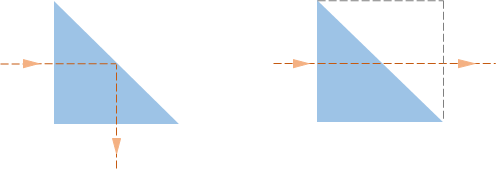Optical prisms have at least two polished and flat surfaces which are designed to perform different functions such as changing the direction of light, combining or splitting optical beams, providing proper image orientation, dispersing light, or creating beam displacement. You can find Precision Prisms being used in optical systems for a variety of applications including direct view systems, multi-channel instruments, spectrometers, imaging cameras, laser scanners, anamorphic systems, and more.
Prisms may be presented as a plane parallel optical plate in applications such as changing light beam displacement, direction, and image orientation. The thickness of the glass plate is obtained by unfolding the prism at its reflection surfaces, unfolded prisms are shown in the form of a tunnel diagram. Figure 1 shows an example of a Right-angle Prism and its corresponding tunnel diagram. Figure 2 shows an example of a Penta Prism and its corresponding tunnel diagram.


We offer standard prisms and also high precision prisms with great angle accuracy in various shapes, configurations, substrates and custom coatings. Our standard prisms include Right-angle Prisms, Corner Cube Prisms, Wedge Prisms, Roof Prisms, Dove Prisms, Polygon Prisms, and more. Our custom anti-reflection and reflection coatings cover wavelength ranges including UV, UV-VIS, VIS, VIS-NIR, SWIR, MWIR, LWIR, and multiple laser line options. On our site you will also find Precision Prisms with arcsecond angle tolerance which are designed to meet the most demanding needs in systems that require critical alignments. This includes precision imaging displacement systems, projection systems, and beam combiner systems.When a prism cube is used in a collimated laser beam system, it does not introduce aberrations. In a convergent or divergent beam system, a prism introduces both monochromatic and chromatic aberrations. Optical designers need to correct these aberrations during the optimization of the system with the prism equivalent block of glass.

A single or multiple reflection surfaces can exist inside the glass block of a prism. A Right-angle Prism, shown in Figure 1, has a single reflection surface and produces a left-handed image when a right-handed image enters the prism. On the other hand, a Penta Prism, shown in Figure 2, has two reflection surfaces and produces a right-handed image when a right-handed image enters the prism. The general rule is that an odd number of reflections produces a left-handed image, and an even number of reflections produces a right-handed image. Figure 3 shows some examples of right-handed images and left-handed images.
Please contact us for any of your custom optics solution needs.
Click here for our Optical Prisms Page.
Click here for our Introduction to Different Types of Optical Prisms Page.